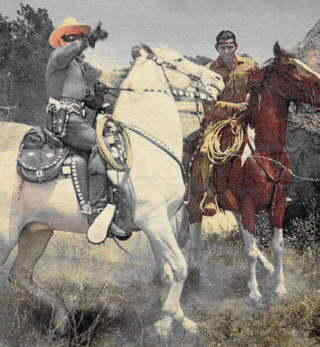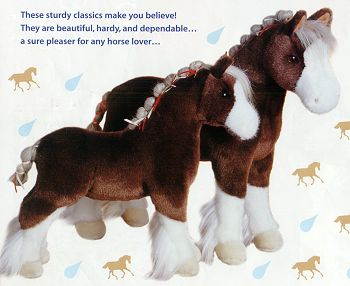|
|
Teaching your Horse to Stand
Ron Meredith
Getting a horse to stand still is all about getting its attention.
Heeding teaches you to keep your attention on the
horse so that the horse will keep his attention on you. Once you
have the horse's attention, you use your body position to create
pressures or shapes that, in turn, create a feeling in the horse
that he should move forward or left or right or stop. You can
also direct him to stand still in one spot while you work around
him or the farrier works around him or you want to put on his
saddle.
The first place this giving and receiving of attention starts is
in grooming. So that's where standing still also starts. You must
pay attention to the horse while grooming. This is very important
in terms of horse logic. The horse allows itself to be groomed
and you honor the horse by grooming him. In the horse's mind,
grooming is about a whole lot more than brushing off dirt.
You start building a relationship with the horse through
scratching or brushing the places the horse loves to be groomed.
If you give him the freedom to move, he'll move around and change
his posture to show you exactly where he wants you to scratch.
The horse's secondary or neutral line runs through his shoulders
so, horse logically, that's the most comfortable place to start.
You're not putting any pressure on him when you're standing at
his shoulder facing him. Work out gradually from this comfortable
spot towards places that are instinctively uncomfortable for the
horse like scratching from his withers up his neck, down his
front legs or around his back legs. Never surprise the horse
about where you're going.
In the beginning, the horse may need to be tied. But the best way
to groom is to have the horse loose in a big enough place that he
can move around to show you were he wants to be scratched or he
can leave you if he wants. Let the lead rope trail on the ground
and, if he wants to leave, let him go. When he steps on the lead
rope, he'll interrupt his leaving and think about whether that
was a comfortable thing to do.
If he starts to leave, just calmly back up out of his kicking
range so he can go by quietly. Don't chase him. Keep his
attention on you with just enough sound or movement, just enough
fuss, that his ears swivel towards you. You want an intense level
of attention not an intense level of activity. Eventually the
horse will turn around and face you to see what the fuss is all
about. Then you stop fussing, walk up quietly to his shoulder on
that neutral line through his withers and start grooming again.
You want to create the feeling in the horse that standing there
quietly with you is the most comfortable place to be.
Your goal is to make standing next to him and grooming him so
comfortable that the horse wants to groom you back. If you are
working with a baby horse that has a tendency to bite or nip,
stabilize his lower jaw with a dropped noseband. You don't want
to have to slap him when he reaches around to groom you. In the
horse's mind, grooming you in return for your favor of scratching
him is a proper, horse-logical thing to do. A slap would spoil
the feeling of quiet and trust you are trying to build. Instead,
when the horse reaches around to groom you, just quietly slide
your hand up his neck and push gently against the back of his
jowl. This reinforces the feeling that the thing you want him to
do is just stand there quietly.
The Lone Ranger and Silver, Tonto and Scout

As you groom, move your primary line around the horse in a
circle. That means when you're alongside the horse facing him,
all of your motion is sideways. When you want to leave the horse
and have him stand, return sideways to that neutral line running
through his withers and back straight out. When you are far
enough away that the horse looks to see what you're doing, turn
halfway around so your back is to him. Now walk away.
In the beginning, the horse is going to think, "Hey, he's gone."
Then the horse feels free to wander off while you're going to get
the brush or the blanket or whatever. So you go back to making
that little fuss, getting his attention back on you, getting him
facing you, then you just calmly go back to whatever it was you
were doing.
Wherever the horse stops and says, "I'm listening again," you go
over and work with him there. Don't move him back to the original
spot you were working because this changes the issue for the baby
horse. Your intention to keep the horse paying attention is the
secret to creating the feeling that he should just stand there
when you leave.
Over a period of time, the horse comes to understand that he
should just stand there when you are alongside him, he should
stand there when you're doing things out away from him, and he
should just stand there when other people like the farrier or the
vet or a judge are walking around him. You are teaching him a
pattern that you want to become a habit.
This habit also gives you a safe way to leave a horse you're
turning out without getting kicked or run over. When you're
leaving the horse in a spot he doesn't have to stay until you
return, you leave by a slightly different route. Back out far
enough on the horse's neutral line to be out of kicking range,
then turn so your primary line is parallel to the horse's and
leave to the rear. If the horse doesn't move off, you can swing
your primary line behind him to create a feeling that you are
following or chasing to communicate that he can move off now.
In the training sequence, keeping the horse's attention on you at
every moment is not critical once you and the horse have
developed a bigger relationship. But in the beginning, keep the
horse's attention on you is the basis of everything else.
© Ron Meredith: Instructor and trainer
http://www.meredithmanor.com
Plush Stuffed Horses - the Perfectly Enjoyable Gift Idea!

Never again have a dull day with our Remarkable Horse Calendars
|